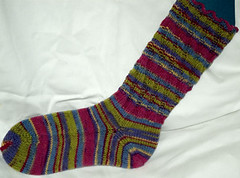
Starting Anew
Once again it's New Year's Eve--time to consider everything that's happened in the past year, and make resolutions (which will be abandoned by January 2).
All in all, 2010 was fairly uneventful. I finished graduate school. The high school I've taught at for the past fourteen years was slated for closure in 2011. I got braces put on my teeth. We pulled the building permits to replace the foundation under the house. We've survived colds, cold weather, and a squirrel in the house. Good-bye, 2010!
Some resolutions for 2011:
1) Blog on a regular basis. I'm really bad about this--I have lots of lovely ideas, but never get around to typing them up. Perhaps I need to invest in a piece of dictation software such as Dragon Naturally Speaking (this is not a plug for them) so I can dictate my email and blog posts while knitting. I'm a bit leery of this software--I tried it about ten or twelve years ago, and it didn't like the way I pronounce certain letters. I'm also not sure how it will respond to my mumbling around my braces.
2) Get back to living a healthy lifestyle. Eat less. Move more. Reduce stress. 'Nuff said.
3) Reduce the size of the stash. The infamous stash has now grown too large for its own good. It's gotten so large that the studio stash closet is full to overflowing, and two tall stacks of bins full of fleece and fiber are stacked in the studio proper. In addition to the bloated stash, I've gone from one loom a year ago to three looms now: I got a Pioneer 16-shaft table loom for sampling in April, and was gifted a 4-shaft Baby Wolf (along with some other equipment) last month. There's barely enough room for me in the studio these days, so reducing the stash should create a bit more space.
4) Get the weaving records organized. I confessed to a bunch of handweavers recently: I am an abject and utter failure at keeping my weaving records organized. How do you keep electronic files, paper notes, photographs, and woven samples all organized neatly? This is a big priority--I've cut projects off two looms in the past two weeks, and both had "issues" because I didn't keep decent records: the five-foot rag rug was actually eight feet long; I used the wrong shade of yellow on some gift towels I was weaving. I need to find a way to keep errors like these to a minimum.
5) Start thinking about life after school. It's time. Barring any unforeseen circumstances, I'm retiring from teaching in less than 61 months. I need to start making some decisions about what I want to do once my life--from August to June--is my own again. Obviously, fiber is going to be a big part of that, but in what ways? As a spinner, a dyer, a weaver, a knitter, a designer, an artist, or a combination of those things? Do I want to design knitting patterns, sell fiber and yarn on the Internet, or create one-off pieces for sale in galleries? Time goes quickly, so if I start thinking about these things this year, I'll have time to take the steps to transition into a very active "retirement."
About the photo: Abracadabra. An original design for a multi-directional lace scarf, knitted from KnitPicks Stroll handpainted sock yarn.







